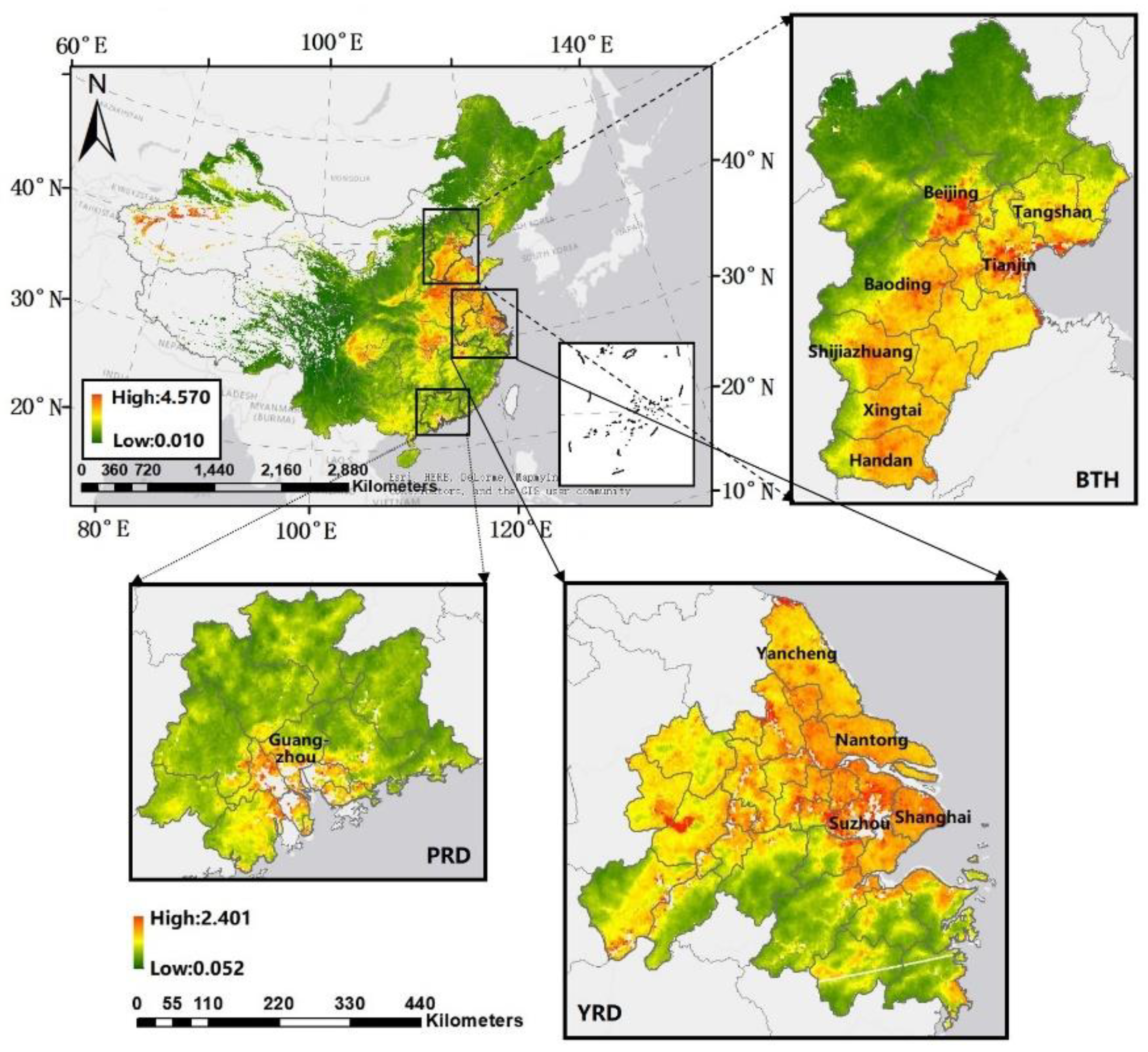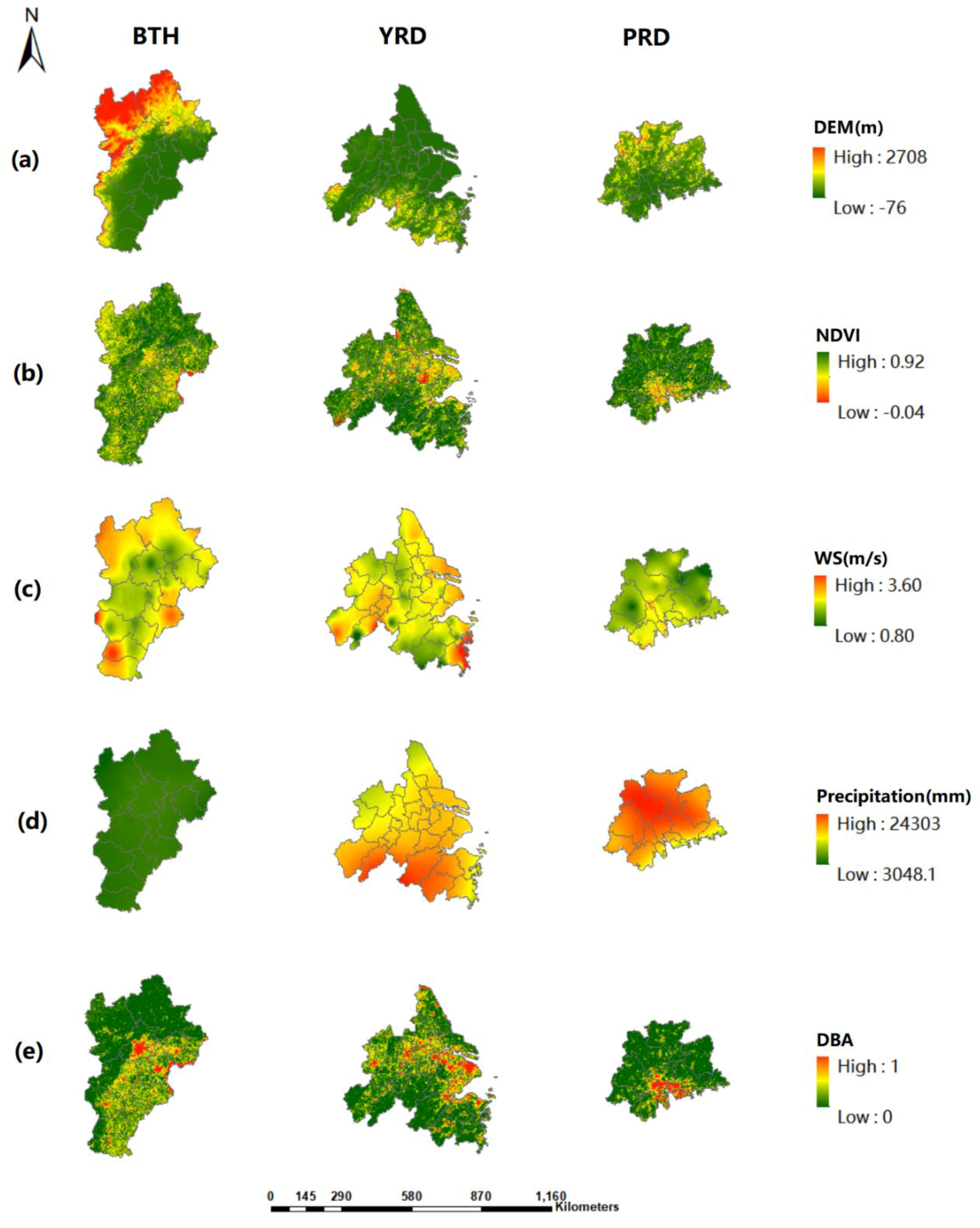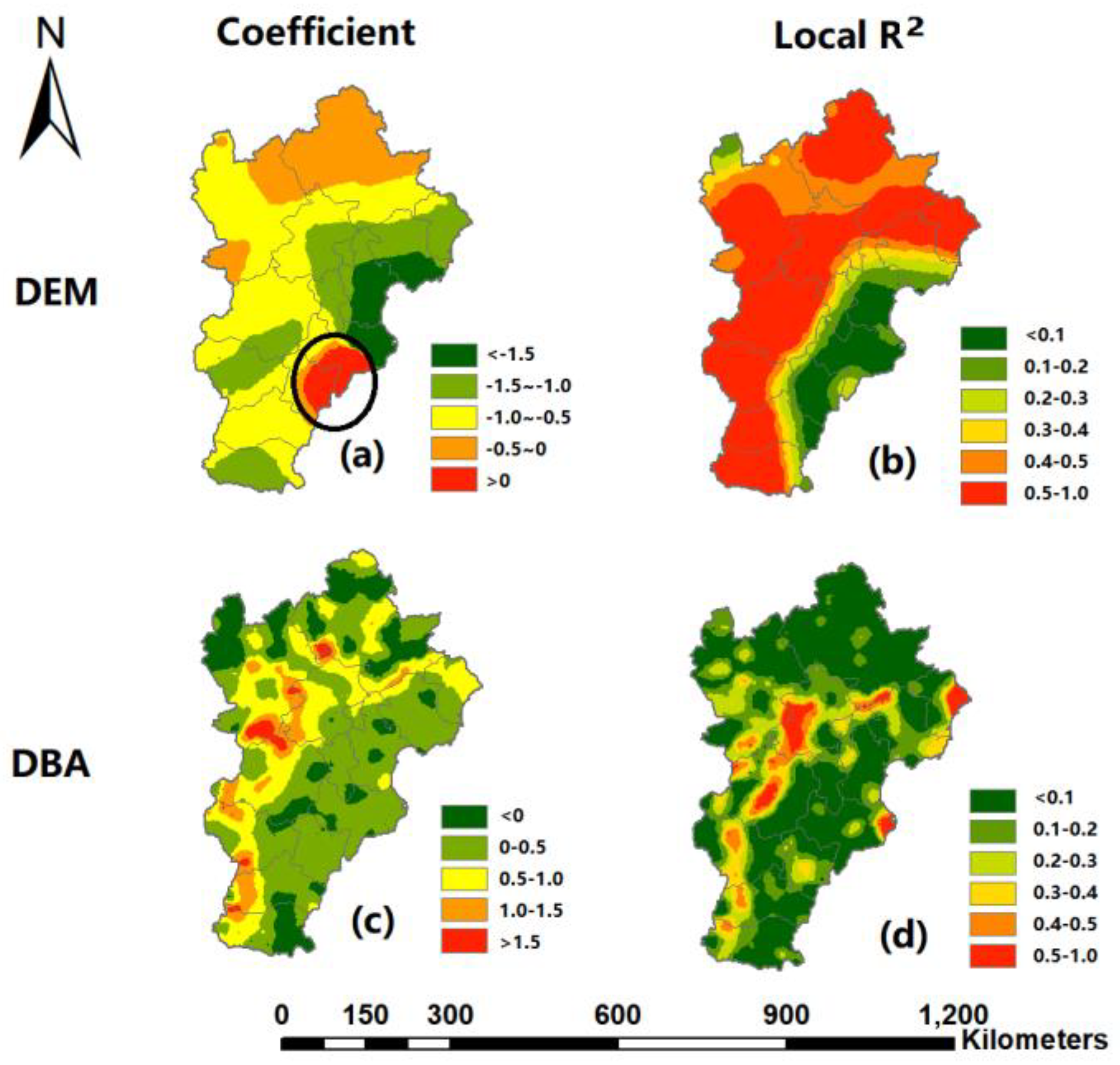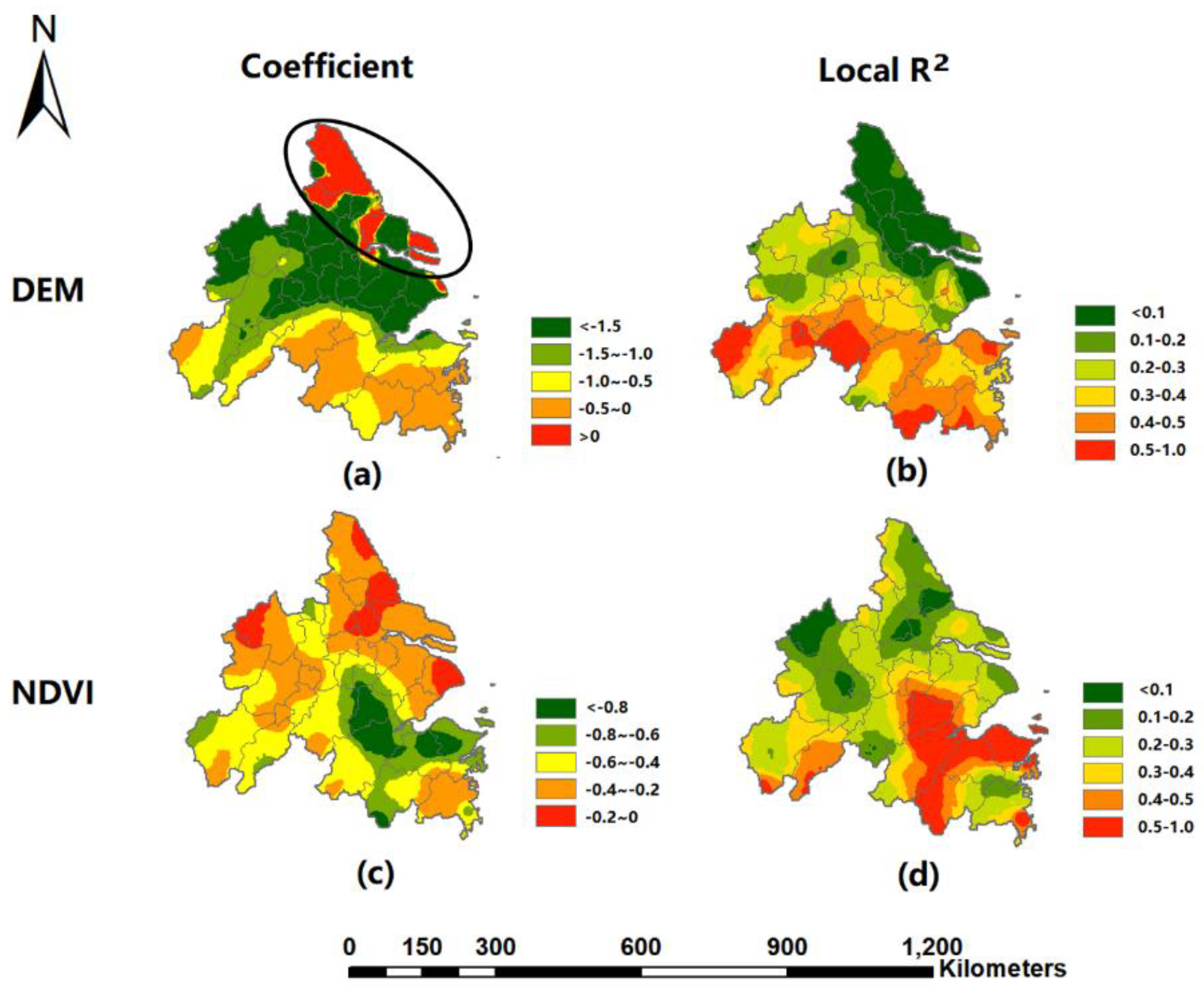Spatial Factor Analysis for Aerosol Optical Depth in Metropolises in China with Regard to Spatial Heterogeneity
Abstract
:1. Introduction
2. Study Area and Data Sources
2.1. Study Area
2.2. Data Sources
3. Methods
3.1. Spatial Autocorrelation Analysis
3.2. Geographically Weighted Regression (GWR)
4. Results and Discussion
4.1. Spatial Distribution of AOD and Its Potential Impact Factors for the Metropolises
4.2. Factor Analysis by GWR and OLS-Based Regression
4.2.1. Model Validation
4.2.2. Spatially Varying Relationship between AOD and Its Impact Factors
5. Conclusions
Acknowledgments
Author Contributions
Conflicts of Interest
References
- Guoshun, Z.; Ronghul, H.; Mingxing, W. Great progress in study on aerosol and its impact on the global environment. Prog. Nat. Sci. 2002, 12, 407–413. [Google Scholar]
- Mao, L.; Qiu, Y.; Kusano, C.; Xu, X. Predicting regional space–time variation of PM 2.5 with land-use regression model and MODIS data. Environ. Sci. Pollut. Res. 2012, 19, 128–138. [Google Scholar] [CrossRef] [PubMed]
- Yan, X.; Shi, W.; Luo, N.; Zhao, W. A new method of satellite-based haze aerosol monitoring over the North China Plain and a comparison with MODIS Collection 6 aerosol products. Atmos. Res. 2016, 171, 31–40. [Google Scholar] [CrossRef]
- Kampa, M.; Castanas, E. Human health effects of air pollution. Environ. Pollut. 2008, 151, 362–367. [Google Scholar] [CrossRef] [PubMed]
- Liu, X.; Chen, Q.; Che, H.; Zhang, R.; Gui, K.; Zhang, H.; Zhao, T. Spatial distribution and temporal variation of aerosol optical depth in the Sichuan basin, China, the recent ten years. Atmos. Environ. 2016, 147, 434–445. [Google Scholar] [CrossRef]
- Kaufman, Y.J.; Tanré, D.; Remer, L.A.; Vermote, E.F.; Chu, A.; Holben, B.N. Operational remote sensing of tropospheric aerosol over land from EOS moderate resolution imaging spectroradiometer. J. Geophys. Res. Atmos. 1997, 102, 17051–17067. [Google Scholar] [CrossRef]
- He, Q.; Zhang, M.; Huang, B. Spatio-temporal variation and impact factors analysis of satellite-based aerosol optical depth over China from 2002 to 2015. Atmos. Environ. 2016, 129, 79–90. [Google Scholar] [CrossRef]
- Guo, Y.; Hong, S.; Feng, N.; Zhuang, Y.; Zhang, L. Spatial distributions and temporal variations of atmospheric aerosols and the affecting factors: A case study for a region in central China. Int. J. Remote Sens. 2012, 33, 3672–3692. [Google Scholar] [CrossRef]
- Li, L.; Wang, Y. What drives the aerosol distribution in Guangdong-the most developed province in Southern China? Sci. Rep. 2014, 4, 5972. [Google Scholar] [CrossRef] [PubMed]
- Feng, X. Research on Spatial Correlation Between Air Quality and Land Use Based on GWR Models. Nat. Environ. Pollut. Technol. 2017, 16, 155. [Google Scholar]
- Dormann, F.C.; McPherson, M.J.; Araújo, B.M.; Bivand, R.; Bolliger, J.; Carl, G.; Kühn, I. Methods to account for spatial autocorrelation in the analysis of species distributional data: A review. Ecography 2007, 30, 609–628. [Google Scholar] [CrossRef]
- Zhang, L.; Bi, H.; Cheng, P.; Davis, C.J. Modeling spatial variation in tree diameter–height relationships. For. Ecol. Manag. 2004, 189, 317–329. [Google Scholar] [CrossRef]
- Mcmillen, D.P. Geographically weighted regression: The analysis of spatially varying relationships. Am. J. Agric. Econ. 2002, 86, 554–556. [Google Scholar] [CrossRef]
- Brunsdon, C.; Fotheringham, A.S.; Charlton, M.E. Geographically weighted regression: A method for exploring spatial nonstationarity. Geogr. Anal. 1996, 28, 281–298. [Google Scholar] [CrossRef]
- Fotheringham, A.S.; Charlton, M.E.; Brunsdon, C. Geographically weighted regression: A natural evolution of the expansion method for spatial data analysis. Environ. Plan. A 1998, 30, 1905–1927. [Google Scholar] [CrossRef]
- Haas, J.; Ban, Y. Urban growth and environmental impacts in Jing-Jin-Ji, the Yangtze, River Delta and the Pearl River Delta. Int. J. Appl. Earth Obs. Geoinform. 2014, 30, 42–55. [Google Scholar] [CrossRef]
- Cui, Y.Z.; Lin, J.T.; Song, C.; Liu, M.Y.; Yan, Y.Y.; Xu, Y.; Huang, B. Rapid growth in nitrogen dioxide pollution over Western China, 2005–2013. Atmos. Chem. Phys. 2016, 15, 34913–34948. [Google Scholar] [CrossRef]
- Xing, Z. Seasonal variation of mass absorption efficiency of elemental carbon in the four major emission areas in China. Aerosol Air Qual. Res. 2014, 14, 1897–1905. [Google Scholar] [CrossRef]
- Zhou, L.; Jiang, Z.; Zhaoxin, L.I.; Yang, X. Numerical simulation of urbanization climate effects in regions of east China. Chin. J. Atmos. Sci. 2015, 39, 596–610. [Google Scholar]
- Li, L.; Qian, J.; Ou, C.Q.; Zhou, Y.X.; Guo, C.; Guo, Y. Spatial and temporal analysis of Air Pollution Index and its timescale-dependent relationship with meteorological factors in Guangzhou, China, 2001–2011. Environ. Pollut. 2014, 190, 75–81. [Google Scholar] [CrossRef] [PubMed]
- Nichol, J.; Bilal, M. Validation of MODIS 3 km Resolution Aerosol Optical Depth Retrievals Over Asia. Remote Sens. 2016, 8, 328. [Google Scholar] [CrossRef]
- Xiao, Q.; Zhang, H.; Choi, M.; Li, S.; Kondragunta, S.; Kim, J.; Holben, B.; Levy, R.C.; Liu, Y. Evaluation of VIIRS, GOCI, and MODIS Collection 6 AOD retrievals against ground sunphotometer measurements over East Asia. Atmos. Chem. Phys. 2016, 16, 20709–20741. [Google Scholar] [CrossRef]
- He, Q.; Zhang, M.; Huang, B.; Tong, X. MODIS 3 km and 10 km aerosol optical depth for China: Evaluation and comparison. J. Atmos. Environ. 2017, 153, 150–162. [Google Scholar] [CrossRef]
- Ma, Q.; Li, Y.; Liu, J.; Chen, J.M. Long Temporal Analysis of 3-km MODIS Aerosol Product Over East China. IEEE J. Sel. Top. Appl. Earth Obs. Remote Sens. 2017, 10, 2478–2490. [Google Scholar] [CrossRef]
- Remer, L.A.; Kaufman, Y.J.; Tanré, D.; Mattoo, S.; Chu, D.A.; Martins, J.V.; Li, R.R.; Ichoku, C.; Levy, R.C.; Kleidman, R.G.; et al. The MODIS aerosol algorithm, products, and validation. J. Atmos. Sci. 2005, 62, 947–973. [Google Scholar] [CrossRef]
- Ghotbi, S.; Sotoudeheian, S.; Arhami, M. Estimating urban ground-level pm 10, using MODIS 3km AOD product and meteorological parameters from WRF model. Atmos. Environ. 2016, 141, 333–346. [Google Scholar] [CrossRef]
- Bilal, M.; Qiu, Z.; Campbell, J.R.; Spak, S.N.; Shen, X.; Nazeer, M. A New MODIS C6 Dark Target and Deep Blue Merged Aerosol Product on a 3 km Spatial Grid. Remote Sens. 2018, 10, 463. [Google Scholar] [CrossRef]
- Bilal, M.; Nichol, J.E.; Chan, P.W. Validation and accuracy assessment of a Simplified Aerosol Retrieval Algorithm (SARA) over Beijing under low and high aerosol loadings and dust storms. J. Remote Sens. Environ. 2014, 153, 50–60. [Google Scholar] [CrossRef]
- Bilal, M.; Nichol, J.E.; Bleiweiss, M.P.; Dubois, D. A Simplified high resolution MODIS Aerosol Retrieval Algorithm (SARA) for use over mixed surfaces. Remote Sens. Environ. 2013, 136, 135–145. [Google Scholar] [CrossRef]
- Dong, Z.P.; Yu, X.; Li, X.M.; Dai, J. Analysis of variation trends and causes of aerosol optical depth in Shaanxi province using MODIS data. Chin. Sci. Bull. 2013, 58, 4486–4496. [Google Scholar] [CrossRef]
- Jin, M.; Shepherd, J.M.; King, M.D. Urban aerosols and their variations with clouds and precipitation: A case study for New York and Houston. J. Geophys. Res. Atmos. 2005, 110, 211. [Google Scholar] [CrossRef]
- Lau, K.M.; Kim, K.M. Observational relationships between aerosol and Asian monsoon precipitation, and circulation. Geophys. Res. Lett. 2006, 33, 320–337. [Google Scholar] [CrossRef]
- Shengtian, Y.; Zhifeng, Y.; Xianqiang, M.; et al. Research on buildings impacting on aerosol diffusing in urban area using remote sensing. J. Environ. Sci. 2004, 16, 509–512. [Google Scholar]
- Moran, P.A.P. Notes on continuous stochastic phenomena. Biometrika 1950, 37, 17–23. [Google Scholar] [CrossRef] [PubMed]
- Geary, R.C. The contiguity ratio and statistical mapping. Inc. Stat. 1954, 5, 115–146. [Google Scholar] [CrossRef]
- Getis, A.; Ord, J.K. The analysis of spatial association by use of distance statistics. Geogr. Anal. 1992, 24, 189–206. [Google Scholar] [CrossRef]
- Thompson, E.S.; Saveyn, P.; Declercq, M.; Meert, J.; Guida, V.; Eads, C.D.; Robles, E.S.; Britton, M.M. Characterisation of heterogeneity and spatial autocorrelation in phase separating mixtures using Moran’s I. J. Colloid Interface Sci. 2018, 513, 180–187. [Google Scholar] [CrossRef] [PubMed]
- Tiefelsdorf, M. Modelling Spatial Processes: The Identification and Analysis of Spatial Relationships in Regression Residuals by Means of Moran’s I; Lecture Notes in Earth Sciences; Springer: Berlin/Heidelberg, Germany, 2000; Volume 87, p. 167. [Google Scholar]
- Tiefelsdorf, M.; Boots, B. The Exact Distribution of Moran’s I[M]//Modelling Spatial Processes; Springer: Berlin/Heidelberg, Germany, 2000; pp. 985–999. [Google Scholar]
- Fotheringham, A.S. Spatial variations in school performance: A local analysis using geographically weighted regression. Geogr. Environ. Model. 2001, 5, 43–66. [Google Scholar] [CrossRef]
- Tu, J.; Xia, Z.G. Examining spatially varying relationships between land use and water quality using geographically weighted regression i: Model design and evaluation. Sci. Total Environ. 2008, 407, 358–378. [Google Scholar] [CrossRef] [PubMed]
- Foody, G.M. Geographical weighting as a further refinement to regression modelling: An example focused on the NDVI–rainfall relationship. Remote Sens. Environ. 2003, 88, 283–293. [Google Scholar] [CrossRef]
- Wang, X.; Fei, Z.; Jing, Y.; Zhang, H.; Zhe, L. Relationship between land cover-landscape spatial characteristics and aerosol optical depth in Ebinur Lake Watershed. Trans. Chin. Soc. Agric. Eng. 2016, 32, 273–283. [Google Scholar]
- Hou, C.; Jiang, H.; Wang, X.; Pei, H. The spatial-temporal evolution of aerosol optical depth and the analysis of influence factors in Bohai Rim. Inst. Phys. Publ. 2014, 17, 012035. [Google Scholar] [CrossRef]
- Burnham, K.P.; Anderson, D.R. Model Selection and Multimodel Inference: A Practical Information-Theoretic Approach; Springer Science & Business Media: Berlin, Germany, 2003. [Google Scholar]
- Tie, X.; Cao, J. Aerosol pollution in China: Present and future impact on environment. Particuology 2009, 7, 426–431. [Google Scholar] [CrossRef]
- Streets, D.G.; Bond, T.C.; Carmichael, G.R.; Fernandes, S.D.; Fu, Q.; He, D.; Klimont, Z.; Nelson, S.M.; Tsai, N.Y.; Wang, M.Q.; et al. An inventory of gaseous and primary aerosol emissions in Asia in the year 2000. J. Geophys. Res. Atmos. 2003, 108, GET30-1. [Google Scholar] [CrossRef]
- Zhang, T.; Wei, G.; Wei, W.; Ji, Y.; Zhu, Z.; Huang, Y. Ground level PM2.5 estimates over china using satellite-based geographically weighted regression (GWR) models are improved by including NO2 and enhanced vegetation index (EVI). Int. J. Environ. Res. Public Health 2016, 13, 1215. [Google Scholar] [CrossRef] [PubMed]
- Van, D.A.; Martin, R.V.; Spurr, R.J.; Burnett, R.T. High-Resolution Satellite-Derived PM2.5 from Optimal Estimation and Geographically Weighted Regression over North America. Environ. Sci. Technol. 2015, 49, 10482–10491. [Google Scholar]
- Lin, C.H.; Wen, T.H. Using Geographically Weighted Regression (GWR) to Explore Spatial Varying Relationships of Immature Mosquitoes and Human Densities with the Incidence of Dengue. Int. J. Environ. Res. Public Health 2011, 8, 2798–2815. [Google Scholar] [CrossRef] [PubMed]
- Ping, L.V.; Zhen, H. Affecting factors research of Beijing residential land price based on GWR model. Econ. Geogr. 2010, 3, 472–478. [Google Scholar]





| Type | Independent Variable | Abbreviation | Data Source | Description | Year |
|---|---|---|---|---|---|
| Natural factors | Digital Elevation Model | DEM | Data Central, Institute of Geographic Sciences and Natural Resources Research, Chinese Academy of Sciences | 1-km resolution | - |
| Normalized Difference Vegetation Index | NDVI | Data Central, Institute of Geographic Sciences and Natural Resources Research, Chinese Academy of Sciences | 1-km resolution | 2015 | |
| Wind Speed | WS | National Centers for Environmental Information (NCEI) of National Oceanic and Atmospheric Administration (NOAA) | - | 2015 | |
| Precipitation | - | Data Central, Institute of Geographic Sciences and Natural Resources Research, Chinese Academy of Sciences | 1-km resolution | 2015 | |
| Land-use cover related factors | Density of Built-up Area | DBA | Data Central, Institute of Geographic Sciences and Natural Resources Research, Chinese Academy of Sciences | 1-km resolution | 2015 |
| Study Area | Moran’s I | Z-Value | P-Value |
|---|---|---|---|
| BTH | 0.940 | 26.770 | 0.000 |
| YRD | 0.715 | 44.615 | 0.000 |
| PRD | 0.680 | 29.805 | 0.000 |
| Study Area | DEM | NDVI | WS | Precipitation | DBA |
|---|---|---|---|---|---|
| BTH | −0.86 | −0.19 | −0.25 | 0.26 | 0.60 |
| YRD | −0.69 | −0.62 | 0.18 | −0.40 | 0.46 |
| PRD | −0.60 | −0.63 | 0.47 | −0.27 | 0.58 |
| Study Area | Impact Factor | R2 | AICc | Moran’s I of Residuals | |||
|---|---|---|---|---|---|---|---|
| OLS | GWR | OLS | GWR | OLS | GWR | ||
| BTH | DEM | 0.74 | 0.87 | −1269.04 | −1910.11 | 0.50 | 0.48 |
| DBA | 0.36 | 0.94 | −388.55 | −2283.29 | 0.69 | 0.13 | |
| YRD | DEM | 0.47 | 0.83 | −756.74 | −1607.89 | 0.50 | 0.11 |
| NDVI | 0.38 | 0.81 | −608.21 | −1579.58 | 0.56 | 0.12 | |
| PRD | DEM | 0.36 | 0.87 | −1355.72 | −2435.66 | 0.59 | 0.03 |
| NDVI | 0.39 | 0.8 | −1410.09 | −2219.33 | 0.54 | 0.19 | |
| DBA | 0.33 | 0.83 | −1317.59 | −2209.06 | 0.66 | 0.12 | |
| Study Area | DEM | NDVI | DBA |
|---|---|---|---|
| BTH | −0.84 | - | 1.19 |
| YRD | −0.89 | −0.69 | - |
| PRD | −0.50 | −0.48 | 0.69 |
© 2018 by the authors. Licensee MDPI, Basel, Switzerland. This article is an open access article distributed under the terms and conditions of the Creative Commons Attribution (CC BY) license (http://creativecommons.org/licenses/by/4.0/).
Share and Cite
Shi, H.; He, Q.; Zhang, W. Spatial Factor Analysis for Aerosol Optical Depth in Metropolises in China with Regard to Spatial Heterogeneity. Atmosphere 2018, 9, 156. https://doi.org/10.3390/atmos9040156
Shi H, He Q, Zhang W. Spatial Factor Analysis for Aerosol Optical Depth in Metropolises in China with Regard to Spatial Heterogeneity. Atmosphere. 2018; 9(4):156. https://doi.org/10.3390/atmos9040156
Chicago/Turabian StyleShi, Hui, Qingqing He, and Wenting Zhang. 2018. "Spatial Factor Analysis for Aerosol Optical Depth in Metropolises in China with Regard to Spatial Heterogeneity" Atmosphere 9, no. 4: 156. https://doi.org/10.3390/atmos9040156




